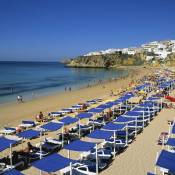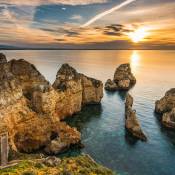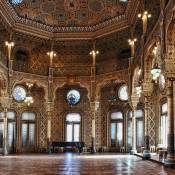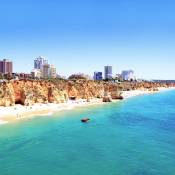11 Best Things to Do in Coimbra
Showing 1 - 11 of 11

Igreja de Santa Cruz Rei-artur | BY-SAThe Monastery or Church of Santa Cruz in Coimbra is rich in both architecture and history. Founded in 1131 by the canons of St Augustine the current building dates back to the 16th century and is a rich example of early Manueline styling.
Originally the monastery would have been a fairly simple Romanesque structure, although the order accumulated considerable wealth and influence. Such was its importance in the early days of Portugal that the first two kings, Afonso Henrique (1109-1185) and his successor Sancho I (1154-1211) were...
2. Sé Nova

Sé Nova de Coimbra José Luis Filpo Cabana | BY-SASé Nova means new cathedral, but this is only relatively speaking. The cathedral building dates back to the late 16th century and was built by the Jesuit Order. However, in 1759 were banned from operating in Portugal by then prime-minister, the Marquis de Pombal.
With this spacious, modern church now vacant it was decided in 1772 that the episcopal seat be transferred from the old Romanesque cathedral to here. Henceforth this was referred to as the Sé Nova (New Cathedral) and the older church the Sé Velha (Old Cathedral).
The church itself still retains some of its Jesuit...
3. Sé Velha

Se Velha - Coimbra Concierge.2C | BY-SAThe Sé Velha (Old Cathedral) of Coimbra is said to be the finest example of Romanesque architecture to be found in Portugal. Dating back to the beginning of the 12th century it was built as a statement of the new nation's triumph over the Moors at the Battle of Ourique. Unlike many of Portugal's grand early buildings much of the original Romanesque design remains intact, although there are many subsequent embellishments.
First impressions of the cathedral, particularly from the main façade, can be a little underwhelming. It is somewhat austere resembling a fortress with its thickly...
Exquisitely ornate Baroque library of the University of Coimbra. Around 250 thousand volumes are contained within this priceless icon of Portuguese culture.
Founded in 1772 by the Marquis of Pombal, the botanical gardens are located in the heart of Coimbra. The 13ha gardens contain plant species from around the world, laid out both logically and aesthetically

Convento de Santa Clara-a-Velha José Luis Filpo Cabana | BY-SAFounded in 1314 by Queen Isabel (Elizabeth of Aragon), the Gothic Convento de Santa Clara was built close to the banks of the River Mondego, across from Coimbra. Isabel was the wife of king D. Dinis and it is said she was most generous and sympathetic towards the poor. In fact the story goes that the king had to reign in Queen Isabel's spending.
Upon the death of King Dinis, Isabel retired to the Santa Clara convent and joined the Order of St Francis, devoting herself to helping the poor and the sick. She died in 1336, 10 years after her husband, and was buried in the convent that...

Portugal dos Pequenitos José Goncalves | BY-SAPortugal dos Pequenitos can translate as "Portugal of the Little Ones" or "Portugal for the Little Ones". Either one would be appropriate for this Portugal in miniature which will particularly appeal to younger visitors. Founded by Professor Bissaya Barreto, a local doctor and lecturer at the medical school, his goal for the park was to be "a living portrait of what it is to be Portuguese and the Portuguese presence throughout the world". The result is both entertaining and educational with a range of scaled-down versions of Portugal's finest national...
8. Conimbriga
The Roman settlement of Conímbriga was one of the largest in Portugal and is today the best preserved and most impressive. The ruins of this ancient town are situated in the countryside around 16 km (10 miles) south of Coimbra, in central Portugal.
Conímbriga as a settlement dates back to before the arrival of the Romans in Portugal. Originally it was occupied by the Celts (briga meaning defended area in Celtic) but what you see today is the work of the Romans who arrived here in the 2nd century BC, during the reign of Emperor Augustus.
Well...
Predating Portuguese sovereignty, the castle of Montemor-o-Velho is a listed National Monument. Perched on a hilltop overlooking the flood plains of the Mondego the castle still dominates the skyline. There has been a fort or castle of some sort here presiding over and protecting the Mondego valley from as long ago as 2000 BC.
The imposing castle we see today dates back to the 13th century with some 16th century additions. Besides the walls and towers there isn't really that much still standing today. There are the ruins of the Paço das Infantas Palace, a favoured royal residence in...
10. Penela Castle

Penela Castle Adriao | BY-SACastle built to defend Coimbra from the potential reconquest of the region by the Moors. The existing structure dates back to the mid 12th century
11. Soure Castle

Soure Castle David Miranda | BY-SASmall, simple 11th century castle built to defend against the reconquest of Portugal by the Moors.

Coimbra travel guide »
In terms of historic significance and romantic beauty, Coimbra is second only to Lisbon and Oporto. Its ancient buildings cling to the side of the hill that rises above the curves of the ...











 Albufeira
Albufeira





 Cascais
Cascais


